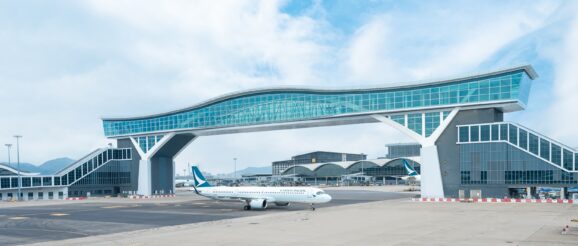Hong Kong airport’s latest innovation offers view to a thrill

Hong Kong has always been among the world’s most spectacular destinations and the experience begins with the sheer and visceral thrill felt when you seem to fly into the city, quite literally.
For people of a certain age, this all dates back to the days of the old airport at Kai Tak – a facility that lined Victoria Harbor in the very heart of the city – and to the white-knuckle ride into land that saw the buildings feel so close to the aircraft you could almost reach out and help Hong Kongers hang out their laundry.
While the experience might have changed since the Hong Kong International Airport (HKIA) shifted operations to the reclaimed land around Chek Lap Kok Island, off Lantau Island on the city’s western fringes, the sense of excitement still remains. Flights now descend from a bird’s-eye view of Hong Kong’s stunning mix of lush, rolling greenery and urbanity, with its sci-fi inspired towers reaching towards the sky.
On opening in 1998, Chek Lap Kok set new standards in terms of the airport arrival experience with its open-planned, hanger-like arrival halls and sophisticated, futuristic designs that ensured ease of access and a seamless travel experience. Its creation was a marvel of engineering in itself as around 550 million cubic meters earth was laid out to ensure the land was suitable for both the airport’s immediate needs, and for future expansion.
Airports around the world quickly followed suit and in the years following, the airport welcomed around 75 million travelers a year at the height of its use and upwards of 5 million tons of cargo in 2018, the most of any airport on the planet.
Now celebrating its 25th year, the HKIA has kept looking for ways to innovate its operations, and to expand the travelling experience for those who come to town. The latest of these innovations is the Sky Bridge, a part of the HK$9 billion Terminal 1 Enhancement Projects, and now linking the airport’s Terminal 1 (T1) and the T1 Satellite Concourse. This mostly glass structure affords stunning, Instagram-ready views out over the airport to the countryside while allowing the largest aircraft on earth to pass right beneath your feet.
Now claimed to be the “world’s longest air-side bridge that allows the largest passenger aircraft to pass under it”, this monument to modern engineering cuts out the need for a bus trip between T1 Satellite Concourse and T1 – saving up to 20 minutes per trip – and while that’s its primary function, the payoff for travelers are those photo-ready moments.
The Sky Bridge stretches for 200 meters and sits more than 28 meters off the tarmac, high enough to allow space enough for an A380 – the world’s largest passenger plane – to pass underneath. When one does, the glass flooring means you can often peer down straight into the cockpit.
The Sky Bridge concept first started to take shape back in 2017 but the scale of the project – in the end the steel structure would weigh more than 5,000 tons – meant it needed to be prefabricated off-site, in order to minimize any impact its building and installment might have on the day-to-day operations of the airport.
So the three precast segments that would go on to form the structure were first built and assembled in Zhongshan – usually a 90-minute fast ferry trip to Hong Kong – and then were separated and delivered in three stages to the assembly yard in HKIA. There the segments were assembled again to form the main structure of the Sky Bridge. The main structure of the bridge was then transported to the final position overnight when the runway was usually shut down for maintenance.
“We were able to have a digital rehearsal which helped us to find the shortest route and fine tune our plan,” explains Ricky Leung, executive director, engineering and technology at Airport Authority Hong Kong. “We could also review our design from a passenger’s point of view. It is a good example of synergy between engineering and technology.”
Today, visitors to Hong Kong are sharing the thrill of the Sky Bridge with friends and family back home. As Steven Yiu, the executive director of airport operations, explains, it’s another “one-of-a-kind experience” you can only get from visiting Hong Kong.
